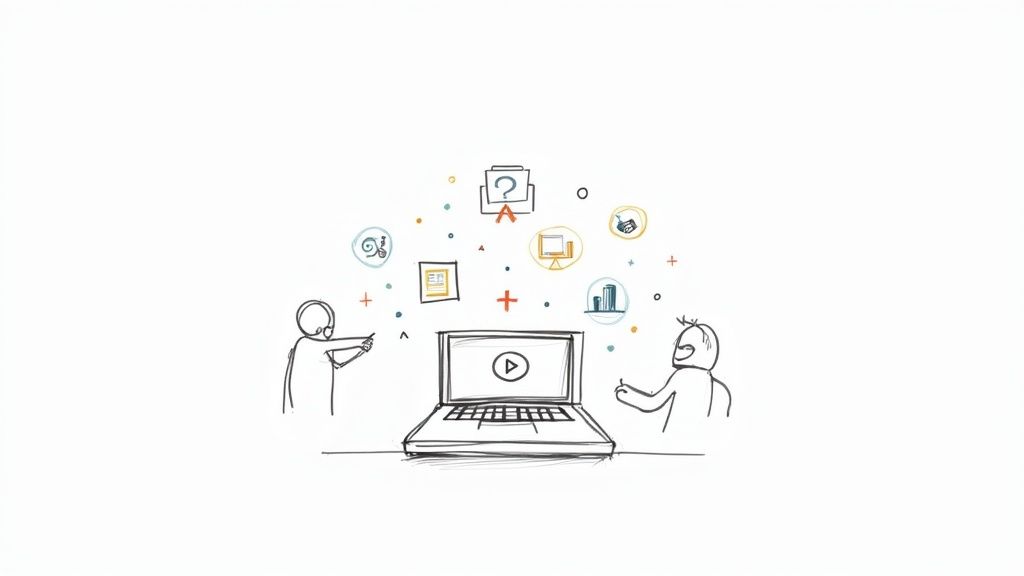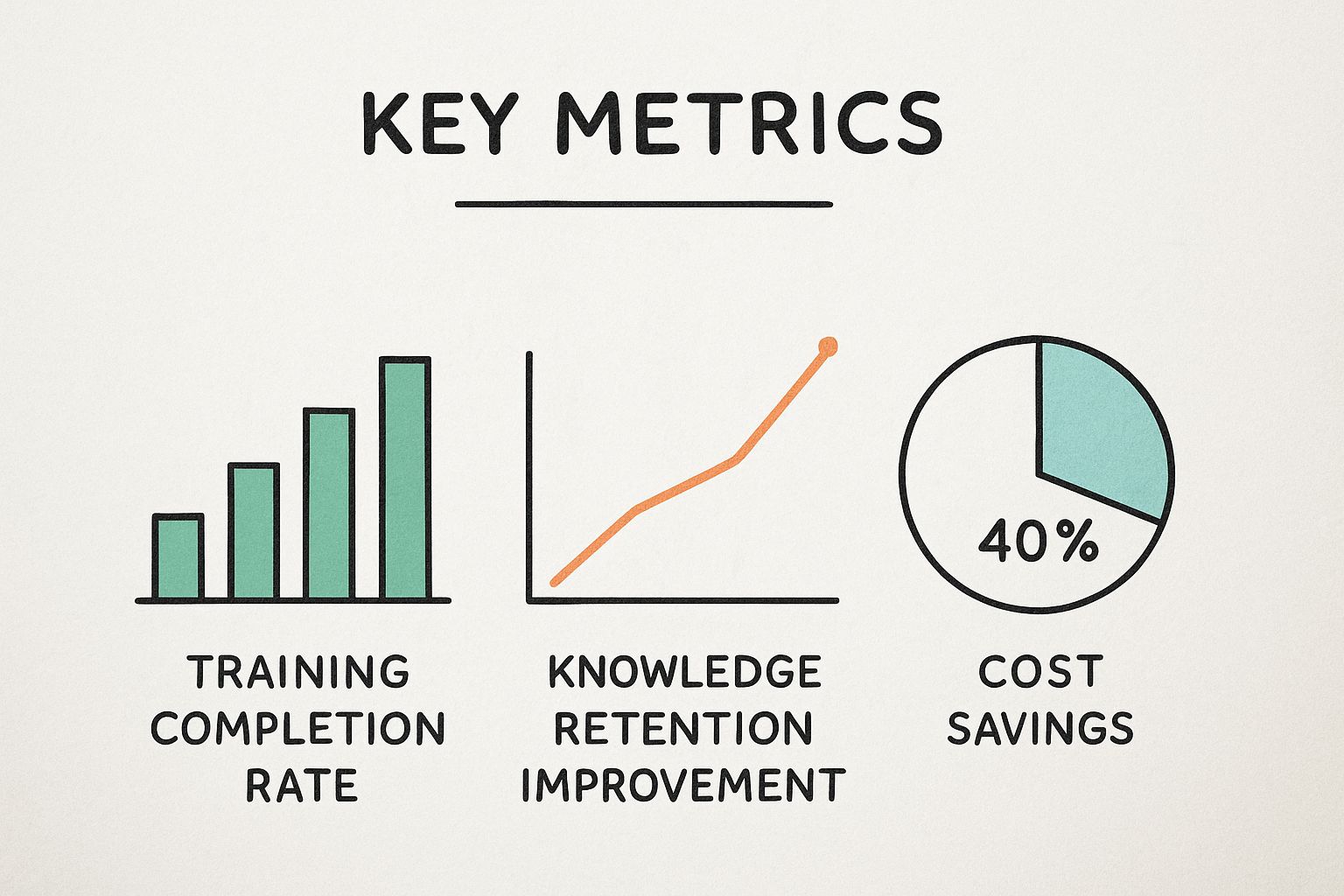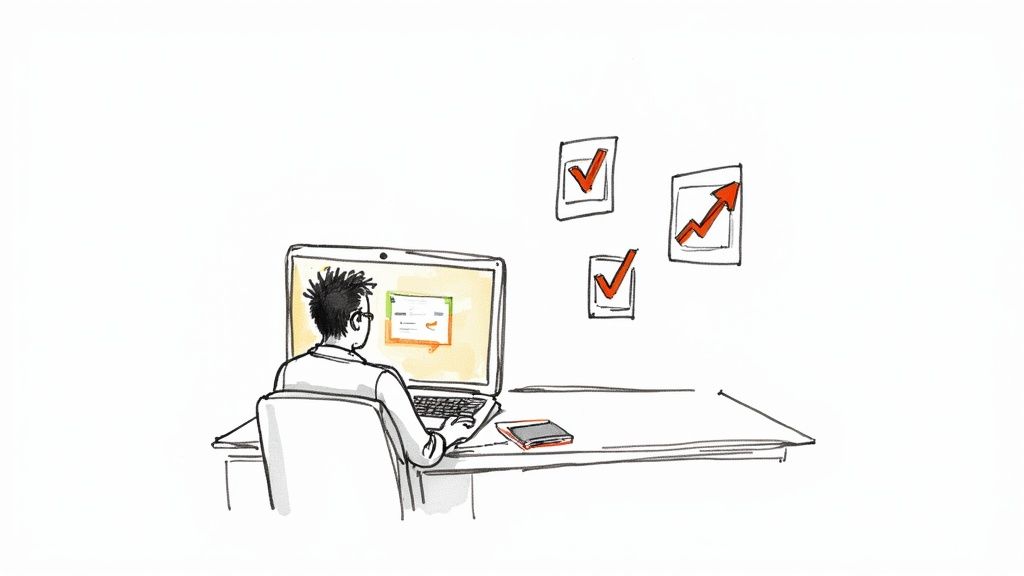
A Guide to Employee Video Training
Employee video training is a strategic approach to corporate learning and development, using video to deliver everything from new hire onboarding essentials to advanced skill-building. It’s a significant move away from outdated handbooks and costly, one-off seminars. Instead, it provides dynamic, on-demand learning that fits how modern corporate teams work and learn.
This approach gives employees the control and flexibility to learn at their own pace, ensuring training is accessible whenever and wherever it's needed to support their professional development.
Why Employee Video Training Is a Must-Have Strategy
In today's corporate environment, video training is no longer a "nice-to-have" — it's a core component of a sophisticated talent development strategy. Companies are moving away from traditional methods because video directly addresses today's biggest corporate training challenges. It supports geographically dispersed teams, meets the demand for scalable training, and delivers content that employees actually want to engage with.
Here’s a simple analogy for corporate development: a printed manual is like a static map. It provides directions, but that's it. An employee training video, however, is like a guided tour with an expert. It shows the landmarks, points out potential roadblocks, and shares critical insights along the way. That's the real power of using video for corporate training.
Driving Scalable and Cost-Effective Learning
One of the most significant advantages of video is its incredible scalability. A single, high-quality training video can be used to educate hundreds, or even thousands, of employees across different offices and time zones. This immediately eliminates the recurring costs associated with in-person sessions, such as travel, venue rentals, and instructor fees.
This visual breakdown shows just how much video training moves the needle on key business metrics like completion rates, knowledge retention, and, of course, cost savings.

The data speaks for itself. Organizations that embrace video for corporate training don't just spend less; they achieve far better learning outcomes.
The financial upside is substantial. The corporate eLearning market, with video as a major component, was valued at $245.5 billion in 2022 and is projected to nearly double. Consider IBM, which saved $200 million by shifting portions of its corporate training to an eLearning model. The outcome? Managers learned five times more content for just one-third of the original cost. You can dive deeper into these corporate eLearning statistics to see the full impact of this trend.
Let's compare the two approaches side-by-side to make the distinction clear.
Traditional vs. Video Training A Quick Comparison
This table highlights the key differences between traditional corporate training methods and a modern, video-based approach. It's clear why video is superior for scalability, cost-effectiveness, and learner engagement.
As you can see, employee video training isn't just a minor upgrade; it's a fundamental improvement across the board, making corporate learning more efficient and effective for the entire organization.
Boosting Knowledge Retention and Engagement
Beyond the bottom line, video is a powerful tool for making information stick. Our brains are wired to process visual information far more effectively than text alone. When you add audio, motion, and storytelling, you create a learning experience that is genuinely memorable and impactful.
Employee video training is about more than just broadcasting information; it’s about creating an engaging learning experience. It makes complex topics easier to understand and ensures that crucial knowledge isn't just seen, but is absorbed and retained for when it matters most on the job.
This high level of engagement translates directly into improved performance. Employees who deeply understand their roles and feel confident in their skills are more productive, make fewer errors, and deliver better customer service. By investing in a robust employee video training program, you aren't just fulfilling a requirement—you're building a smarter, more capable, and agile workforce.
How Video Training Boosts Engagement and Retention
When you invest in your team's professional development, you send a clear message: "We value you, and we are committed to your success here." High-quality employee video training is one of the most effective ways to deliver on that promise, directly impacting employee engagement and loyalty. It's not a perk; it's a fundamental element of a healthy, thriving corporate culture.

When employees have the tools to master their roles and can see a clear path for development, their commitment to the company deepens. This isn't just a feel-good theory—it’s a proven strategy for driving retention and defending against costly turnover. Effective video training builds confidence, and confident employees are committed employees.
Fostering Loyalty Through Better Learning
Think about a time you felt truly supported in your career. It likely involved being given the resources needed to overcome a challenge. Employee video training provides that support on-demand, making your team feel capable, respected, and valued. It signals that the company is invested in their growth, which builds significant long-term loyalty.
The data tells a compelling story. When companies offer solid training opportunities, up to 80% of employees say they'd stick around longer. Even more telling, a staggering 92% of employees reported higher engagement levels as a direct result of workplace training. Investing in your team’s skills doesn't just make them better at their jobs; it strengthens their commitment to the company. You can dig deeper into how structured training impacts key business metrics to see the full picture.
When corporate training is accessible, relevant, and engaging, it becomes a cornerstone of the employee experience. It transforms a job into a career path, making your organization a place where people don't just work—they grow.
This is a critical shift in perspective for reducing employee turnover. When people feel stagnant or unsupported, they begin looking for other opportunities. A robust video training library is a constant, visible sign of your investment in their future.
Unlocking Productivity with On-Demand Knowledge
Engagement isn’t just about employee satisfaction—it’s about driving performance. This is where video training truly excels, fueling productivity by delivering knowledge exactly when and where it's needed. Instead of waiting for a scheduled workshop or tracking down a busy subject matter expert, an employee can access a short video tutorial and solve a problem in minutes.
Imagine a new sales representative preparing for a crucial client call. They can quickly watch a two-minute video on handling a specific objection right before dialing. This is just-in-time learning, empowering them to apply new skills instantly and boosting both their confidence and performance. This immediate access removes friction and encourages employees to take ownership of their professional development.
The benefits are clear and measurable:
- Reduced Downtime: Your team spends less time searching for answers and more time executing their tasks.
- Faster Skill Application: The gap between learning and doing virtually disappears, accelerating mastery of new skills.
- Increased Autonomy: Staff feel more empowered to handle challenges independently, freeing up managers and senior team members to focus on higher-level strategic work.
This creates a powerful positive feedback loop. As employees use on-demand video to improve at their jobs, their satisfaction and engagement increase. They feel more effective, which motivates them to learn even more. Ultimately, employee video training builds a more resilient, capable, and committed workforce—an investment that pays dividends in both culture and performance.
Creating Training Videos That Actually Work
Knowing you should use video for employee training is one thing; creating videos that engage your team and drive learning outcomes is another. A shaky, unscripted phone video won't meet corporate standards. To transform passive viewing into active learning, your videos require a solid foundation of instructional design and thoughtful production.
Think of it as consulting with a trusted expert. The best training videos are clear, direct, and focused on helping an employee solve a real-world problem or learn a new skill. It’s not about flashy effects—it’s about delivering the right information in a way that’s easy to digest and apply.
Start with a Solid Script
Before you even think about recording, you need a script. This is the most critical step. A well-written script ensures your content is concise, accurate, and logically structured. Attempting to "wing it" almost always leads to rambling, missed key points, and a video that requires extensive editing or a complete reshoot.
Your script is your blueprint for effective corporate training. It forces you to define your learning objectives and organize the material before production begins. A good rule of thumb is to aim for a script of about 750 words for a five-minute video. This maintains a brisk pace and prevents viewer fatigue. Remember, clarity is paramount. Avoid jargon and use simple, direct language that is easily understood across the organization.
This example from Mindstamp's homepage demonstrates how clear, benefit-focused language can explain a platform's value—a principle that is essential for scripting effective training content.
The screenshot gets right to the point: making videos more powerful. Your script should do the same for your training topic—make a complex idea feel simple and actionable.
Embrace Microlearning Principles
Let's be realistic: attention spans are short and corporate schedules are packed. This is where microlearning becomes your secret weapon. Instead of creating a single, hour-long training module, break your content into a series of short, focused videos. Each video should cover a single, specific learning objective.
Microlearning isn’t about simplifying your content; it’s about making it more accessible. A library of 5-minute videos on distinct tasks is far more effective and usable than one long training module that employees don't have time to complete.
This approach offers significant benefits for video training for employees:
- Higher Completion Rates: Employees are far more likely to watch a 3-minute video during a coffee break than a 30-minute one.
- Better Knowledge Retention: Focusing on one concept at a time helps the information stick.
- On-Demand Problem Solving: When an employee encounters an issue, they can quickly access the exact video they need to solve the problem immediately.
Prioritize Audio and Visual Quality
You don't need a Hollywood production budget, but poor visuals or crackly audio will instantly make your video feel unprofessional and undermine its credibility. If your team has to strain to hear or squint to see the screen, they will disengage quickly. These two elements are non-negotiable for effective corporate training.
- Audio is Paramount: Invest in a quality external microphone. The built-in mic on a laptop or camera will pick up distracting background noise. Clean, crisp audio conveys authority and professionalism.
- Visuals Must Be Clear: Ensure good lighting and a stable camera (a tripod is essential). If you are creating a screen recording, verify that the resolution is high enough for all text to be perfectly legible.
The goal is to remove any friction that hinders the learning process. By focusing on a tight script, bite-sized lessons, and quality production, you’re not just creating training that informs—you’re creating a learning experience that respects your employees' time and attention.
Transforming Learning with Interactive Video

Producing high-quality training videos is a major step forward, but it's only half the equation. The real transformation in employee video training happens when you shift learners from passive watching to active participation. This is where interactive video becomes a powerful tool for corporate development, turning a one-way lecture into a hands-on, two-way learning experience.
Instead of just pressing play, employees become active participants in the learning process. We're not talking about simple "like" buttons; this is about integrating meaningful engagement points that demand focus and reinforce key learning objectives. Platforms like Mindstamp are designed specifically for this, allowing you to add elements that fundamentally change how your team learns.
Beyond Play and Pause: The Power of Active Participation
Consider this: standard video training is like sitting in a large lecture. You might take notes, but you are fundamentally a passive recipient of information. Interactive video, however, is like a corporate workshop where the facilitator constantly asks you to apply what you are learning on the spot. This active involvement is the key to making information stick.
Research supports this. People remember information 67% better when it's in a video versus text alone. When you add interactivity, that retention skyrockets, allowing employees to absorb more knowledge in less time. Companies using video training tools already see an 18% boost in learner engagement, a figure that grows when active participation is required. You can dive deeper into the data on how video improves employee training outcomes.
By requiring learners to interact, you're not just hoping they paid attention—you're ensuring it. This active participation is the key difference between content that is simply viewed and knowledge that is truly understood and retained.
This hands-on approach is the perfect solution to the "in one ear, out the other" problem that affects so much corporate training. When an employee must make a choice or answer a question, their brain engages on a completely different level.
Building Engaging Learning Experiences
So what does this interactivity look like in a corporate training context? It's about using smart tools to create knowledge checks and decision points directly within your videos. With platforms like Mindstamp, you don't need to be a developer to build these dynamic learning experiences.
Here are a few powerful ways to make your employee training interactive:
- Embedded Quizzes: Imagine a new compliance video. Instead of hoping employees caught the key policies, you can insert a short quiz after each major section. They must answer correctly to proceed, guaranteeing comprehension.
- Clickable Hotspots: Teaching a new software application? Place clickable hotspots over different buttons or menus in your screen recording. When a viewer clicks, a pop-up can provide more detail, turning a simple demo into an exploratory learning tool.
- Branching Scenarios: This is a game-changer for soft skills and leadership training. A sales training video could present a common customer objection. The employee then clicks to choose a response, and the video branches to a scene showing the outcome of that choice. It's a safe environment to practice, fail, and learn from mistakes.
These features provide learners with immediate, personalized feedback. If someone answers a question incorrectly, the video can automatically direct them back for a quick review before they try again, creating a customized learning path for every employee.
From Engagement to Actionable Data
Perhaps the greatest benefit for L&D and management is the data generated by interactive employee video training. With a standard video, your metrics are limited. You know who watched and for how long, but you have no insight into whether they actually understood the material.
Interactive video changes everything. By asking questions and tracking choices, you get a rich stream of data that reveals exactly what your team is learning and, more importantly, where they are struggling.
Interactive Video Metrics That Matter
This type of data is invaluable for any L&D department. You can finally stop guessing and start making data-driven decisions to refine your content, identify employees who need extra support, and prove the real-world value of your corporate training programs.
Building and Launching Your Video Training Program
So, you’ve mastered creating some solid training videos. That's a huge first step. But how do you go from making one-off videos to building a full-blown training program that actually becomes part of how your company operates?
It’s about being deliberate. A successful rollout isn’t just about hitting "publish." It’s a thoughtful process that turns a collection of videos into a core part of your company's DNA—something that’s organized, effective, and gets your team genuinely interested in learning.
Think of it like building a house. You wouldn’t just show up with a hammer and some nails and hope for the best. You need a blueprint. The same goes for your training program. You have to lay the foundation with clear goals, get the right tools for the job, and map out a plan before you even think about building your content library.
Laying the Strategic Foundation
First things first: what are your learning objectives? Don't just aim to "create training." Get really specific. After watching a video, what exactly should an employee be able to do? Should a new hire know how to complete a specific task in your CRM? Or should a manager understand the precise steps for conducting a performance review that aligns with company policy? These clear objectives are your North Star, guiding every single decision you make from here on out.
Once you know what you want to achieve, you’ll need stakeholder buy-in. This is where you have to talk business. Securing a budget and proving the program’s value isn't about asking for money for "video training." It's about showing how this program solves real problems. Frame your pitch around tangible outcomes, like explaining how it will slash onboarding time by 25% or dramatically reduce costly compliance mistakes. When you build a solid business case, the investment feels less like an expense and more like a smart, strategic move.
Choosing Your Technology and Building a Calendar
Your technology stack is the engine that powers this whole operation. You'll need creation tools, of course, but the real game-changer is the platform you use to host and deliver the training. This is where a platform like Mindstamp becomes so crucial. It’s not just a video locker; it’s a tool that turns passive viewing into active, engaging learning and gives you the hard data to prove your program is working.
With your tech in place, it’s time to build a content calendar. This isn’t just a schedule—it’s your strategic roadmap. It maps out what training gets released and when, tying everything back to your company's biggest priorities.
A well-structured content calendar ensures your training efforts are proactive, not reactive. It allows you to anticipate needs—like training for a new product launch or upcoming compliance deadlines—and deliver timely, relevant content that makes a real impact.
Here’s a quick look at what your calendar should cover:
- Onboarding Content: A dedicated series for new hires, dripped out over their first 90 days.
- Skill-Based Training: Specific videos covering software, internal processes, or essential soft skills.
- Compliance and Safety: Scheduled releases for mandatory annual or quarterly training.
- Product Updates: Just-in-time training that coincides perfectly with new feature releases.
Driving Adoption and Managing Your Program
You can't just build it and expect them to come. A successful launch hinges on a strong communication plan. Use every internal channel you have—email, team meetings, Slack, company newsletters—to build some genuine excitement.
Focus on what’s in it for them. How will this training make their jobs easier? How will it help them get ahead in their careers or solve those nagging daily frustrations?
Finally, as your video library grows, so does the need for good video library management. Let's be honest, a messy library is an unused library. A logical folder structure and consistent naming conventions are your best friends. Tag videos with relevant keywords so employees can actually find what they're looking for, right when they need it. A searchable, well-organized library is what transforms your training program from a one-time project into a reliable, go-to resource for the long haul.
How to Measure Your Training Program's ROI
Let's be honest: a great training program has to do more than just deliver slick, engaging content. It needs to prove its worth in real-world business terms. If you want to justify the investment in employee video training, you have to look past simple vanity metrics like view counts. The real goal is to calculate a tangible return on investment (ROI) by connecting what your team learns directly to bottom-line results.

This might sound complicated, but the framework is actually pretty straightforward. It all starts with tracking the right data points within your training. From there, you tie that data to the key performance indicators (KPIs) your business already cares about. It's about drawing a clear line from learning to earning.
Connecting Learning Metrics to Business Outcomes
Think of your measurement strategy in layers. You'll start with learning-specific metrics that show your content is actually working. Then, you connect those wins to the business impacts your stakeholders are watching. This is where interactive video becomes a game-changer.
Platforms like Mindstamp give you the kind of detailed analytics that a simple, passive video just can't offer. You can see quiz scores, completion rates, and even how individuals answered specific questions. This gives you hard data on whether the knowledge is sticking. For a deeper dive, check out our guide on the reasons to use interactive video for training.
Proving ROI isn't just about showing that people watched a video. It's about demonstrating that because they watched and understood the content, they are now performing their jobs better, faster, or more safely.
For example, imagine your team achieves a high pass rate on a new safety compliance quiz. If you can show that this directly correlates with a measurable drop in workplace incidents, you've just turned a training expense into a strategic investment. That's the connection that matters.
A Framework for Measuring Success
To build a truly compelling case for your program's value, you need a structured way to track your metrics. The table below breaks down how to link learning data to tangible business results, helping you build a clear and convincing ROI story for anyone who asks.
This table outlines different levels of metrics to track, from basic engagement to tangible business impact, helping you prove the value of your video training program.
Key Metrics for Measuring Training Success
By tracking these interconnected metrics, you create a powerful narrative. You can confidently show stakeholders that your employee video training initiative doesn't just educate—it delivers measurable financial and operational improvements across the entire organization.
Have Questions About Video Training? We've Got Answers.
As more L&D teams adopt employee video training, it's natural for questions to arise about effective implementation. It's one thing to decide to use video, but another to build a corporate training program that employees actually use and learn from.
Let's tackle some of the most common questions from L&D and corporate training leaders.
What Is the Ideal Length for a Training Video?
We've all experienced it—a long, rambling training video that could have been a five-minute email. For corporate training, shorter is almost always better. The sweet spot for engagement and retention is typically between 3 to 7 minutes.
This microlearning approach is perfect for covering a single, specific topic without losing your audience's attention. If you're addressing a large, complex subject, don't try to cram it into one long video. Instead, break it down into a playlist of shorter, bite-sized videos. Your team will find it much easier to digest the information and will be more likely to retain it.
How Can I Make Training Videos Interactive?
This is where you can truly elevate your corporate training, and it's much easier than you might think. You don't need a team of developers. Modern interactive video platforms like Mindstamp were built to make this simple, allowing you to embed interactive elements directly into your videos to engage learners.
Consider adding elements like:
- Questions: Insert multiple-choice or open-ended questions to check for understanding of key concepts.
- Clickable Buttons: Allow viewers to click a button to access supplemental resources, download a PDF, or navigate to a related video.
- Branching Scenarios: Create "choose your own adventure" style training where a learner's choices dictate the video's path. This is exceptionally effective for soft skills or compliance training.
Suddenly, you're not just delivering content; you're creating a two-way learning experience that provides real data on what your team is learning.
When your employee video training is interactive, you're no longer just hoping they paid attention—you're getting proof. This shift from passive viewing to active participation is what separates content that gets watched from knowledge that actually sticks.
How Do I Get Employees to Actually Watch the Videos?
You can create the best corporate training video in the world, but it's useless if no one watches it. Driving adoption comes down to three key things: communication, relevance, and accessibility.
First, you can't just publish content and hope for the best. Announce new training via internal channels—email, Slack, Teams—and be sure to communicate what's in it for them.
Ensure the content is directly relevant to their roles and easily accessible within their workflow. Finally, to understand what's effective, you must track engagement. Learning how to measure training effectiveness gives you the data-driven insights needed to prove your program’s value and continuously improve it over time.
Ready to stop making training videos that just get watched and start creating experiences that get results? Mindstamp makes it simple to build engaging, interactive videos that turn passive viewers into active learners. Explore Mindstamp today and see what a smarter, more capable team looks like.
Get Started Now
Mindstamp is easy to use, incredibly capable, and supported by an amazing team. Join us!



Try Mindstamp Free










